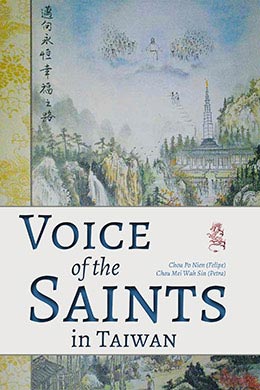Ye Elders of Israel
Missionaries, Seventies, and Apostles (2008–15)
Chou Po Nien (Felipe) (周伯彥) and Chou Sin Mei Wah (Petra) (周冼美華), “Ye Elders of Israel: Missionaries, Seventies, and Apostles (2008-15),” in Voice of the Saints in Taiwan, ed. Po Nien (Felipe) Chou (周伯彥) and Petra Mei Wah Sin Chou (周冼美華) (Provo, UT: Religious Studies Center; Salt Lake City: Deseret Book, 2017), 393-428.
In the years following the fiftieth anniversary of the LDS Church in Taiwan, the Church continued to grow and develop in the island. Key events during this period included calling new Area Seventies and training local missionaries. Various Church leaders, including the Apostles of the Church and other auxiliary leaders, also visited and trained local members.
Area Seventies from Taiwan
New Area Seventies continued to serve and strengthen the Church in Taiwan and throughout Asia. These members of the Quorum of the Seventy in Taiwan were prepared by the Lord and had many years of Church service, including time as stake presidents. Elder Chung Kuo Chiang (Joseph) (仲國強) served as an Area Seventy from 2008 to 2013, and Elder Juan Jui-Chang (阮瑞昌) served as an Area Seventy from 2010 to 2015. Elder Kuan Ming-Shun (關名順) was called as an Area Seventy during the April 2015 general conference. These Area Seventies serve the Saints in Taiwan and throughout Asia.
Elder Chung Kuo Chiang (Joseph)
Elder Chung Kuo Chiang (Joseph) (仲國強) was called as an Area Seventy on 1 April 2008 and served until he was released on 1 April 2013. He was sixteen years old when he met the missionaries and was challenged to read the Book of Mormon. After his baptism, he noted that the Book of Mormon changed his life and inspired him to serve as a full-time missionary. When he began his mission, he was afraid to talk to people because he was worried about being rejected. Nevertheless, he realized that the Book of Mormon changes people’s lives, and in the process of sharing it, he gained an increased knowledge and stronger testimony of the Prophet Joseph Smith. Most importantly, he gained a deeper testimony of the mission of Christ on the American continent and encouraged the members to share the Book of Mormon with others. He went on to study the Book of Mormon with his children since they were very young and they could not read well yet. He said, “Let us diligently study the Book of Mormon daily, ponder carefully, and search to gain a true testimony of the Book of Mormon,” as well as “apply the teachings of the Book of Mormon . . . and by our actions certify that we are true Christians.”[1]
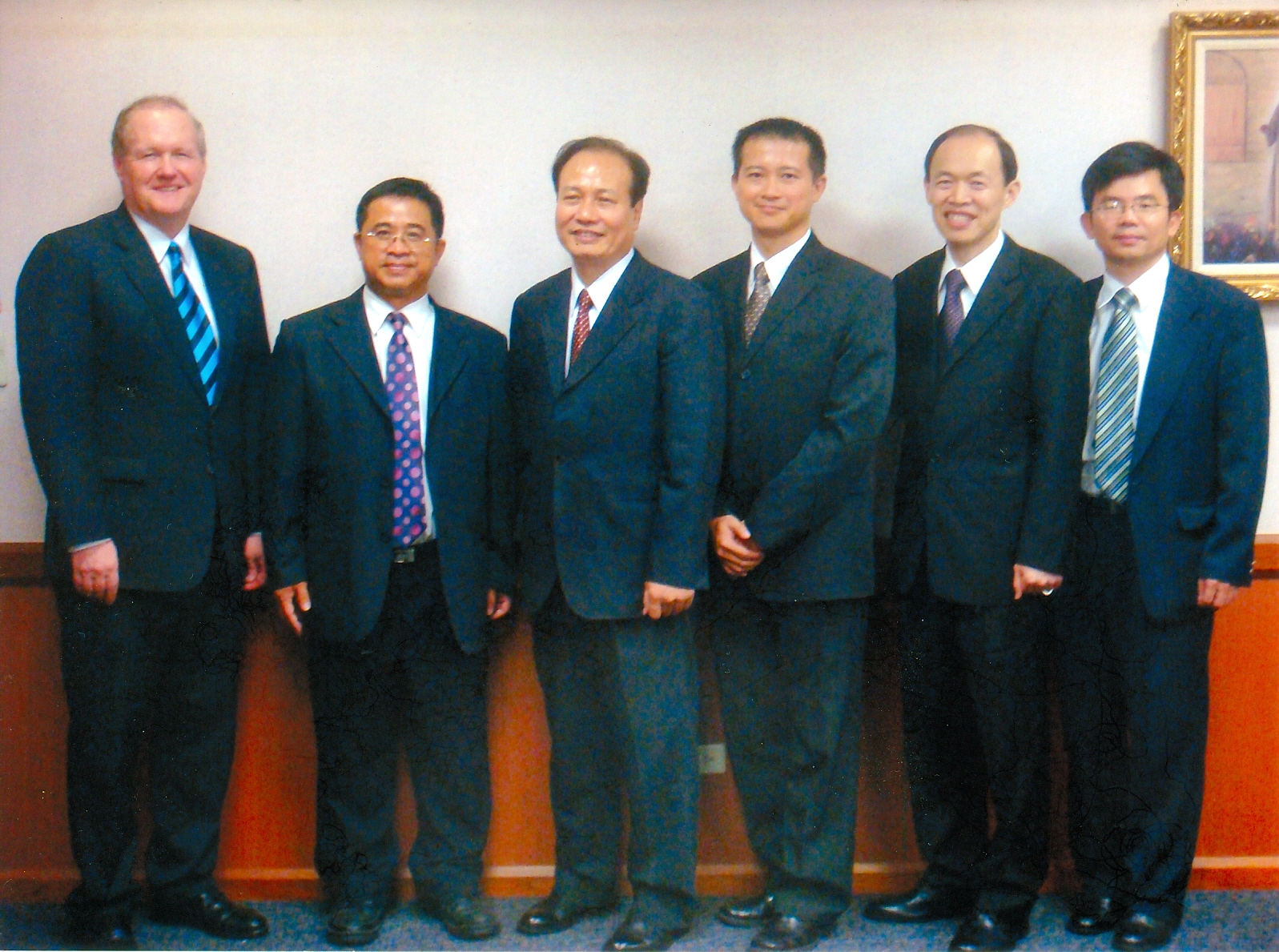 Taichung Taiwan East Stake was organized in 2010. From left to right: President Anthony Perkins (Asia Area President), Chang Chih Hsun (center) with his two counselors, Elders Chung Kuo Chiang (Joseph) and Juan Jui-Chang (Area Seventies). Courtesy of Chang Chih Hsun (Peter).
Taichung Taiwan East Stake was organized in 2010. From left to right: President Anthony Perkins (Asia Area President), Chang Chih Hsun (center) with his two counselors, Elders Chung Kuo Chiang (Joseph) and Juan Jui-Chang (Area Seventies). Courtesy of Chang Chih Hsun (Peter).
Elder Chung worked as the temple recorder for the Taipei temple and encouraged the Saints to go to the temple often. He also served in various Church callings, including stake president of the Taipei Taiwan East Stake from September 1993 until July 2003. Before his call as an Area Seventy, Elder Chung also served as a counselor in the Taipei Mission presidency to President Anthony D. Perkins, later a member of the Quorum of the Seventy. Elder Chung also worked on the revision of the Chinese translation of the scriptures, which was published in 2007.
Elder Juan Jui-Chang
Elder Juan Jui-Chang (阮瑞昌) from Taichung was called as an Area Seventy on 3 April 2010 and served faithfully until he was released on 1 May 2015.[2] Elder Juan first listened to the missionaries when he was sixteen years old. While attending seminary, he was deeply touched by his seminary teacher’s reminder of the prophet’s call for every worthy young man to serve a mission. However, he was unsure how to tell his father of his desire to serve. After praying, he felt the Holy Ghost guide him in his conversation with his father, who gave him permission to go. Elder Juan learned from that experience that one should have faith in God and not avoid confronting challenging situations. Later, as a stake president for the Taichung Taiwan Stake, he always encouraged the youth to go on missions.[3]
His wife, Sister Juan Tsai Chia-Hsiu (阮蔡佳秀), had a similar experience when she wanted to serve a mission. She knew her parents didn’t want her to quit her job and go serve a mission. But after praying, she felt the Holy Ghost guide her in choosing how and when to talk to them. She was also guided to speak to them separately, and in retrospect she realized that had she spoken to them together, they would not have allowed her to go on a mission.[4] Her experience illustrates the importance of prayer and following the guidance of the Spirit as one prepares to serve a mission.
After their missions, Paul Hyer, who was their mission president, encouraged them to date each other, even giving Elder Juan some money for him to take her on a date after he was released as a full-time missionary. At the time, they were returned missionaries with no money and no education. Because they had not completed their education, their parents opposed the idea of their children getting married then. However, rather than wait three years, Brother Juan proposed to his future wife that they get married in three months.[5] Although her parents felt that marrying a man who had no education or money would result in many hardships, Sister Juan felt she was “not marrying for riches, but marrying someone who could take me to heaven.”[6] They were sealed in the temple and were blessed for their decision.
While studying at BYU–Hawaii, they had the opportunity to work, obtain green cards, and stay in the United States. But instead they chose to follow their commitment to return to Taiwan to assist their families and build the Church in Taiwan. Their decision was a blessing to them and their family. After serving as a stake president for the Taichung Taiwan Stake, Elder Juan was called to serve as an Area Authority Seventy. They taught their children that if they would serve God, they would be blessed. All four of their children, except for the youngest who (as of 2016) is not yet of age, have served missions.[7]
Elder Kuan Ming-Shun
Elder Kuan Ming-Shun (關名順) said that meeting the missionaries brought him a mighty change in his heart and was a turning point in his life, providing direction for him. He gained a testimony that he was a child of God with a divine potential.[8] He was baptized in 1988 and has served in various callings in the Church, including as a full-time missionary in the Taipei Mission, as a bishop, as stake president of the Taichung Taiwan North Stake, and finally as an Area Seventy, called in the April 2015 general conference.[9]
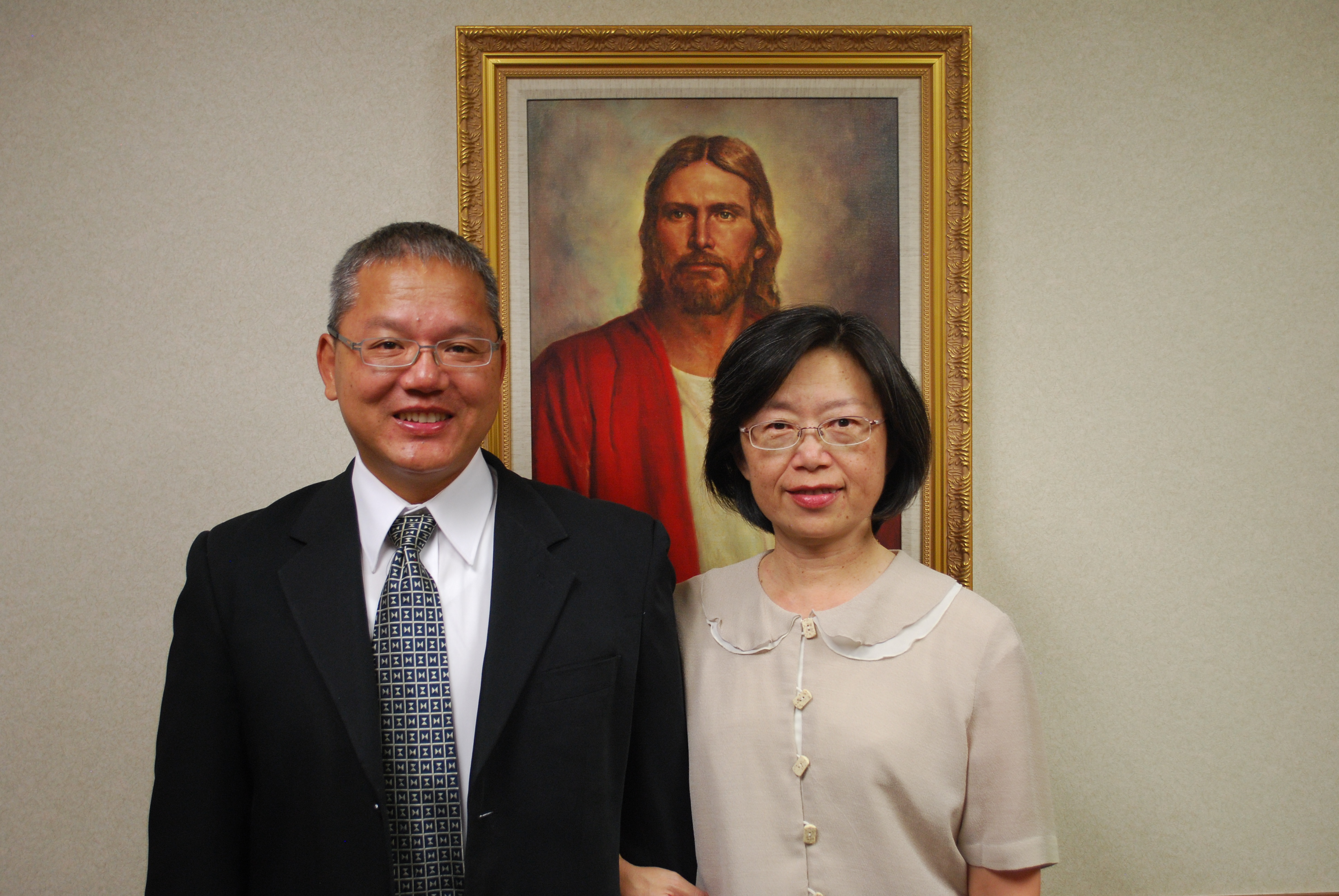 Elder Juan Jui-Chang and his wife, Juan Tsai Chia-Hsiu, in 2015. Elder Juan served as an Area Seventy from 2010 to 2015. Courtesy of Chou Po Nien (Felipe).
Elder Juan Jui-Chang and his wife, Juan Tsai Chia-Hsiu, in 2015. Elder Juan served as an Area Seventy from 2010 to 2015. Courtesy of Chou Po Nien (Felipe).
Elder Kuan shared the following experience about his mission: “I received my mission call to serve in the Thailand Bangkok Mission . . . but when I arrived in Thailand I was told there was an error and after three days I was sent to Taipei. I felt bad, . . . but later I felt grateful to return to Taiwan, to use my own language, to serve my own people.” From his missionary experiences and other callings, he learned not only of the challenges of members but also of the blessings they are promised if they will live the gospel. He had “many opportunities to serve and learn in the Church, which has helped [him] to grow spiritually.”[10]
He attended institute during his college years in Tainan before attending graduate school at Taiwan University, where he met his wife, Kuan Chen Wen-Ling (關陳雯玲).[11] Sister Kuan recalled going with her younger sister to English lessons taught by missionaries at the church. She was baptized in 1992 and met Elder Kuan when they sang together at a stake singles activity. They were married in the Taipei Taiwan Temple in 1997 but were unable to have children. She said, “We went to China, to Hawaii, and tried everything.” After receiving a priesthood blessing, she was able to get pregnant; they now have two children—a girl and a boy.[12]
Prior to Elder Kuan’s call as Area Seventy, Sister Kuan recalled an interview for her husband via Skype in November 2014 with Elder Gerrit Gong, then a member of the Quorum of the Seventy serving in the Asia Area Presidency. They then traveled to Salt Lake City in April 2015 and met with Elder Jeffrey R. Holland of the Quorum of the Twelve, who ordained and set apart Elder Kuan for his calling as an Area Seventy. Shortly after he was sustained during the Saturday session of general conference, they Skyped their children in Taiwan to let them know of the call.[13] Elder Kuan said, “I felt very humbled and inadequate, but I also felt the great blessings from the Lord, giving me the opportunity to be taught by the Lord’s chosen prophet face to face.”[14]
Changes to Missions and the Missionary Program
Missionary work in Taiwan would experience some significant changes during this time. Despite the closure of the Taiwan Kaohsiung Mission, there were openings of missionary work on the small island of Kinmen, innovations to the missionary referral system, expansion of the Church’s online presence, training of local missionaries serving in Taiwan at the Philippines Missionary Training Center (MTC), and changes to military and missionary service.
Mission Closure and the Opening of Small Islands
The Taiwan Kaohsiung Mission was closed for the second time in 2009. This action was, in part, due to the maturity of the Church in Taiwan and the need for missionaries in other parts of the world where the Church was relatively new. Hsu Shiu-Foo (William) (徐筱夫) served as the mission president for the Taiwan Kaohsiung Mission from 2006 until it was closed and consolidated with the Taiwan Taichung Mission in 2009.[15] Elder Phil Frandsen, then first counselor to Hsu in the mission presidency, helped to close the mission and dispose of the assets.[16]
There was great sadness among the Saints in southern Taiwan when the Taiwan Kaohsiung Mission was closed. Notwithstanding, there was also a bright silver lining as the gospel reached out to small islands along the Taiwan Strait between Taiwan and mainland China. Back in 1995, the MaGong Branch of the Church was organized in the small island of Penghu by Karl R. Koerner, then the Taiwan Taichung Mission president. Like other mission branches, the branch president was typically a missionary elder. On 9 September 2007, Hsieh Chu Cheng (謝祖錚) was called as its first local branch president.[17]
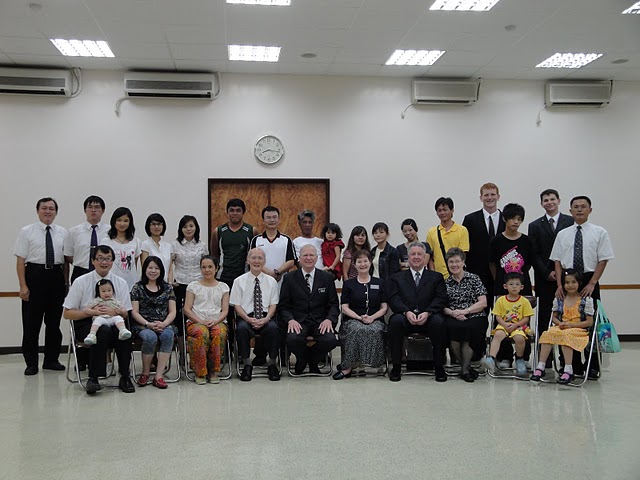 The MaGong Branch in the island of Penghu in 2010. Courtesy of Phil and Brenda Frandsen.
The MaGong Branch in the island of Penghu in 2010. Courtesy of Phil and Brenda Frandsen.
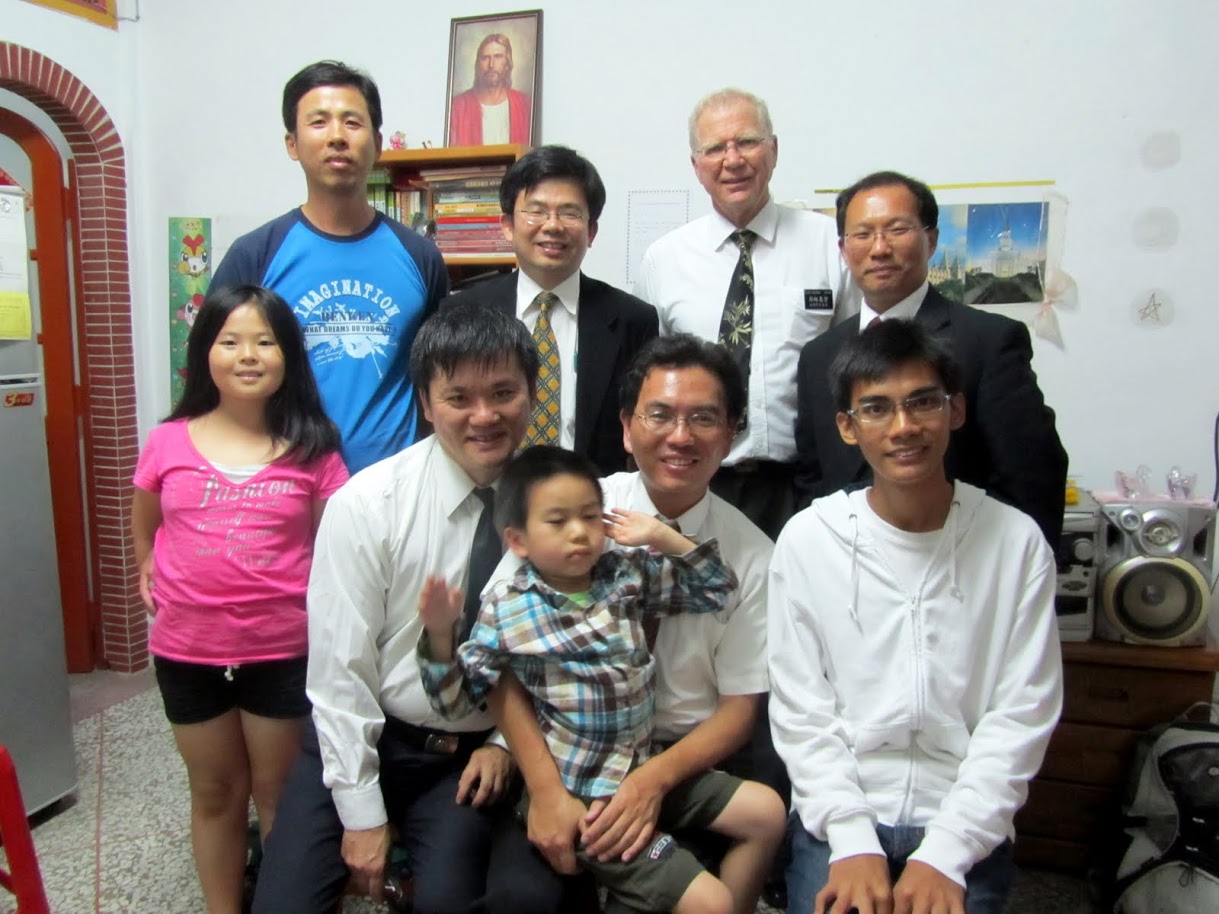 The Kinmen group, circa 2011. Courtesy of Phil and Brenda Frandsen.
The Kinmen group, circa 2011. Courtesy of Phil and Brenda Frandsen.
Brother Huang’s family lived in Kinmen for twenty-five generations. He was introduced to the gospel by his wife, a native from mainland China who joined the Church in Taipei around the time they got married. He was eventually taught the gospel in 2011 over the Internet using MSN video conferencing by missionaries serving at the Taichung Mission office. President Clark Bishop, then president of the Taiwan Taichung Mission, traveled to Kinmen and held a baptismal service at a member’s home, and Huang was baptized in a portable baptismal font. The gospel was beginning to take root on this small island, and in 2013 the Kinmen group was organized on the small island of Kinmen, under the MaGong Branch. The island of Kinmen is only a few kilometers from mainland China.[18] The gospel was reaching out to even the small “isles of the sea.”[19]
New Referral System and Expanding Online Presence
Another innovation that utilized technology for a new referral system was instituted by Michael Hoer, who preceded Clark as the Taiwan Taichung Mission president. President Hoer recognized the need for a better referral system after the following experience was shared by Sister Brenda Frandsen: “[President Hoer and his wife] contacted a man who agreed to have the missionaries teach him. President Hoer recalls that he personally handed the referral card to the mission recorder so the referral process could be shortened. About a week later, President Hoer had the unusual experience of running into the same person again, who said, ‘Hey, didn’t you say that you would send missionaries to teach me? They haven’t called me yet! When are they going to call me?’”[20]
Hoer held a zone leader council to discuss how to improve and expedite the referral system. Elder Ben Hansen, then a zone leader, said, “I can write a Java code program for the cell phone and the missionaries can send referrals directly through their phone.” The new system was implemented in June 2009 and shared with Asia Area leaders. Prior to the new referral system, the Taichung Mission had 3,461 referrals per month, with 15.4 percent added as new investigators. Following the implementation of the new system, missionaries had 4,958 referrals per month, adding 22.9 percent of that as new investigators, more than doubling the number of new investigators from the referrals.[21]
One missionary said, “It made entering referrals a whole lot faster and easier! It’s amazing! It’s using technology for the purposes God wanted it to be used.” Another missionary explained that “by the time you receive referrals in the old way, [the contact] had already lost the Spirit and what it felt like during the contact. But, with the new system, you don’t have that problem” because referrals are contacted within twenty-four hours. In addition, it saved the mission almost $1,000 US dollars per year, since the new monthly cost was only $1.74 US dollars compared to $80 US dollars in fax and other associated costs with the former system. By 2010, the Taiwan Taipei Mission also implemented the new referral system, reporting very positive results as well.[22] This new referral system helped to enhance missionary work in Taiwan.
The Church also continued to utilize other online tools that augmented its presence on the Internet. Sister Brenda Frandsen explained, “The creation of the Taiwan Country website, Facebook page, and Single Adult Facebook groups further propelled the Church in Taiwan into the online world.” The continued development and expansion of lds.org added additional resources for members and nonmembers alike.[23] The Church’s online presence continued to grow in Taiwan, and by 2016 the Mormon Newsroom website was created for Taiwan, making it the eightieth Mormon Newsroom website.[24]
Training of Local Missionaries at the Philippines MTC
Most missionaries receive training at various missionary training centers (MTCs) throughout the world, with the majority of missionaries called to the MTC in Provo, Utah. However, prior to 2000, local missionaries called to serve in Taiwan did not have an opportunity to spend time at an MTC of the Church. Rather, they either reported directly to their mission or received limited training organized by one of the missions in Taiwan.
Although there were earlier training efforts, they were very limited. On 11 November 2000, a Taiwan local “Missionary Training Center” was organized in the Taiwan Taichung Mission. Four local missionaries called to serve in Taiwan—Elders Chang and Tsui, and Sisters Zou and Li (張長老, 崔長老, 周妹妹, 李妹妹)—were the first to attend. The training period lasted from 11 through 20 November, and these missionaries stayed at the mission home and received instructions at the chapel next door. The office elders of the Taichung Mission, the mission president and his wife, and the assistants from the Taichung and the Kaohsiung Missions trained the new missionaries.[25]
According to President Dennis Kim, “All in all it was a great success as the missionaries learned and prepared to go into the field. It was a great opportunity for the natives of Taiwan to prepare for their two-year calling here in Taiwan. Every few months, this locally created MTC would help train a few missionaries.”[26] Although their temporary efforts were limited in scope, they were better than nothing until arrangements were made for Sister Chiu Hsin-Yao (Lena) (邱欣遙) to take the first group of missionaries from Taiwan to be officially trained at the Philippines MTC.
After her mission, Sister Chiu Hsin-Yao (Lena) worked as a part-time secretary for Seminaries and Institutes (S&I) and as part-time translator for the Church at the Taipei Church Administration Building. She explained that around 2006, “the elders from the Taipei Mission began to use one of the classrooms near my [S&I] office to hold a one-week training for Taiwanese missionaries called to serve in Taiwan.” Chiu added, “The Taipei Mission president tried to hold a one-week training experience to provide some training for new missionaries.” This training consisted mostly of guest speakers such as the mission president and his wife, office elders, temple or stake presidents, or other leaders. Chiu explained how she became involved with the first training of the Taiwanese missionaries at the Philippines MTC: “In 2008, Carl Liang was the Taipei Service Center manager and told me they were preparing the Philippines MTC to train missionaries from Taiwan. He asked me to submit a resume and later I had a skype interview with a brother from the Philippines MTC. They hired me and in February and July 2009, I took the first and second group of Taiwanese missionaries to the Philippines MTC, there were six in the first group and fifteen in the second group.”[27]
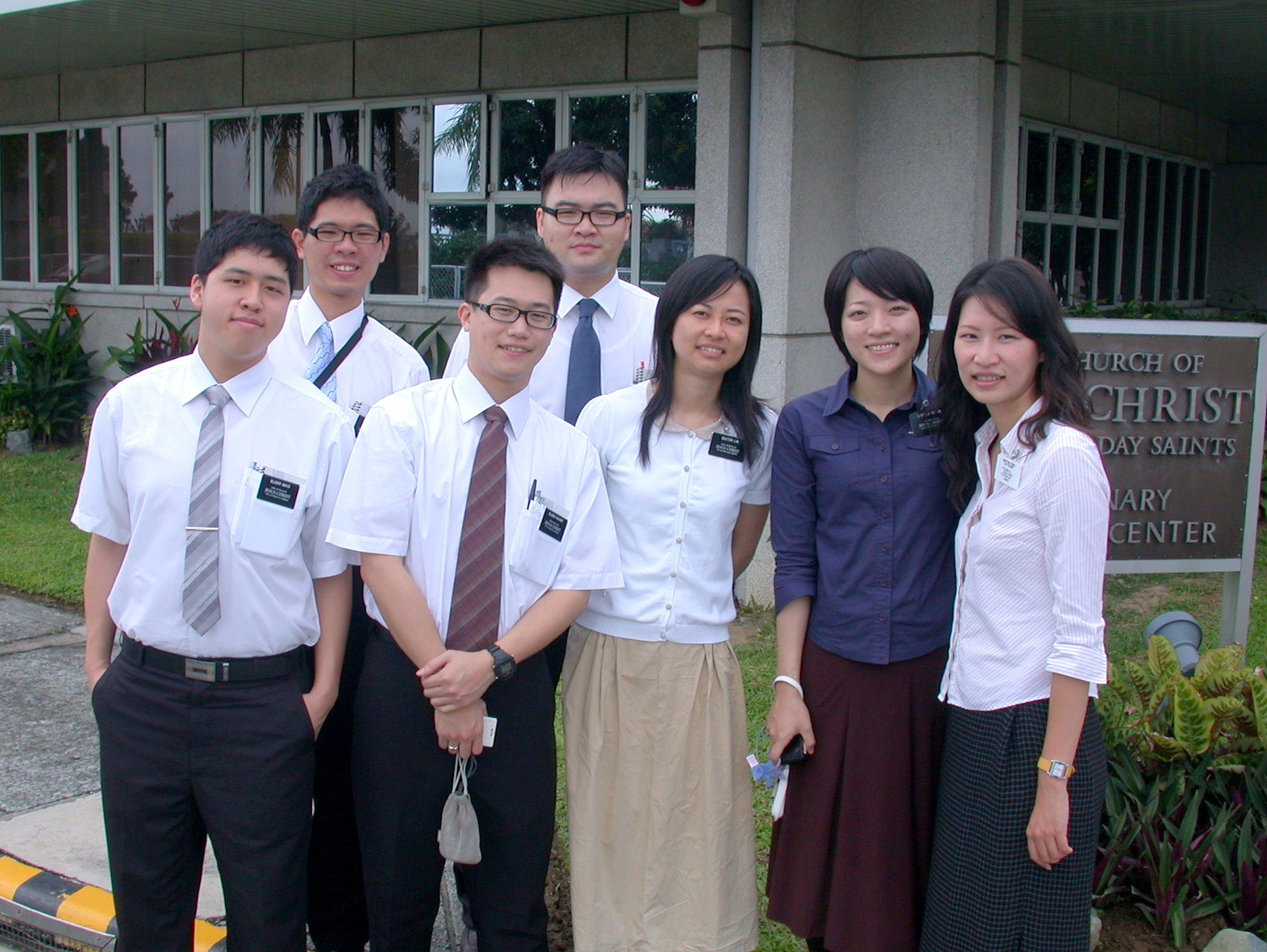 Teacher Chiu Hsin-Yao (far right) with first group of missionaries from Taiwan to train at the Philippines Missionary Training Center in February 2009. Courtesy of Chiu Hsin-Yao (Lena).
Teacher Chiu Hsin-Yao (far right) with first group of missionaries from Taiwan to train at the Philippines Missionary Training Center in February 2009. Courtesy of Chiu Hsin-Yao (Lena).
As a former missionary who served in the United States, Chiu had the opportunity to train at the Provo MTC prior to her mission. Her MTC experience was beneficial, as she was familiar with the teaching, training, and schedule of the Provo MTC. She said, “The Philippines MTC was mapped and organized like the Provo MTC, which I was familiar with from when I served my mission.” As a newly appointed teacher, she flew to the Philippines a week ahead of the missionaries from Taiwan, where she met her companion teachers and received training until the arrival of the Taiwanese missionaries.[28] She related the following about their experience in the Philippines:
A week later, the Taiwanese missionaries would arrive and we would pick them up at the airport. They were in the Philippines MTC for about two or three weeks to receive missionary training. They would learn how to be missionaries, memorize scriptures, learn the lessons, and have a lot of practice time teaching each other the lessons. We were mostly in class, but also went to the temple, exercised, had devotional, prayer meeting, Sunday service or testimony meeting, and so forth; . . . it was model[ed] after the Provo MTC.
I had two companion teachers who were Filipinos, returned missionaries, but who didn’t speak any Chinese. The Philippines MTC had groups of missionaries from seven or eight other places that spoke other languages. I was always with my missionaries, either teaching them or translating when my companion teachers taught. We used Preach My Gospel and both groups had a great experience. It was a blessing for the missionaries in Taiwan to have an MTC experience.[29]
In contrast, Chiu noted that the one-week training in Taipei felt more like an orientation for missionaries going into the field and did not provide the equivalent experience that one would have at an MTC. Since those missionaries lived at the temple patron housing in Taipei and often saw family and friends in the Church complex, it didn’t feel like they had yet started their mission. Chiu explained:
The two groups I taught at the Philippines MTC had a great experience. The experience at the Philippines MTC was quite different than the orientation in Taipei because they were away from their family and friends. They were isolated from the world while at the MTC. These missionaries really felt like they had started their mission. They met missionaries from other countries and cultures, many from the Philippines which helped to give them a new perspective about faith and sacrifice. They loved being with the Filipino missionaries who came from a very different culture. They saw people with literally nothing. Unlike the more affluent Taiwanese missionaries who came from well off or better off families, most Filipino missionaries came from much more humble and less fortunate circumstances. One Filipino missionary walked all the way from his town to come to report to the MTC. This experience blessed these Taiwanese missionaries and helped them to become better missionaries.[30]
The first group of missionaries from Taiwan to train at the Philippines MTC began when it was still under construction, so facilities were limited. After additional buildings were completed, the Philippines MTC was dedicated by Elder Russell M. Nelson of the Quorum of Twelve Apostles on 20 May 2012. He prayed that the Republic of the Philippines would “maintain open doors of welcome” for all the missionaries that would come from various countries, including the Philippines, Cambodia, Hong Kong, India, Indonesia, Mongolia, Pakistan, Sri Lanka, Thailand, and Taiwan.[31]
Changes to Military and Missionary Service
Changes in Taiwan military service requirements and the lowering of the age for missionary service for all young adults further contributed to the increased quantity and quality of local full-time missionaries. Lee Shih-Jung (Robert) (李世榮), who served as the stake president for the Kaohsiung Taiwan Stake, noted that an obstacle hindering young men in Taiwan from serving a two-year full-time mission for the Church was the compulsory two-year military service, mandated by the government for every young man. However, the Taiwanese government gradually reduced required military service time throughout the 2000s, from twenty-four months down to about four months by 2015.[32]
Brother Huang Yong Da (黃永達) noted that decreased military service to four months has allowed many more young men to serve as full-time missionaries shortly after completing their military obligation.[33] Lee Shih-Jung (Robert) (李世榮) remarked, “There are many young men in the Church now that plan to fulfill their four-month military obligation immediately following their high school graduation, and then go out to serve as a full-time missionary for the next two years.” Lee also noted that over several years, there were only about thirty local missionaries serving at one time, but in 2015 there were about three times more missionaries than typical.[34] Sister Mao Chang Mei-Yun (毛張美雲) observed that more young men can now finish their military service and go on a mission right away, and that the age change also allowed the sisters to be able to go earlier at age nineteen rather than twenty-one.[35]
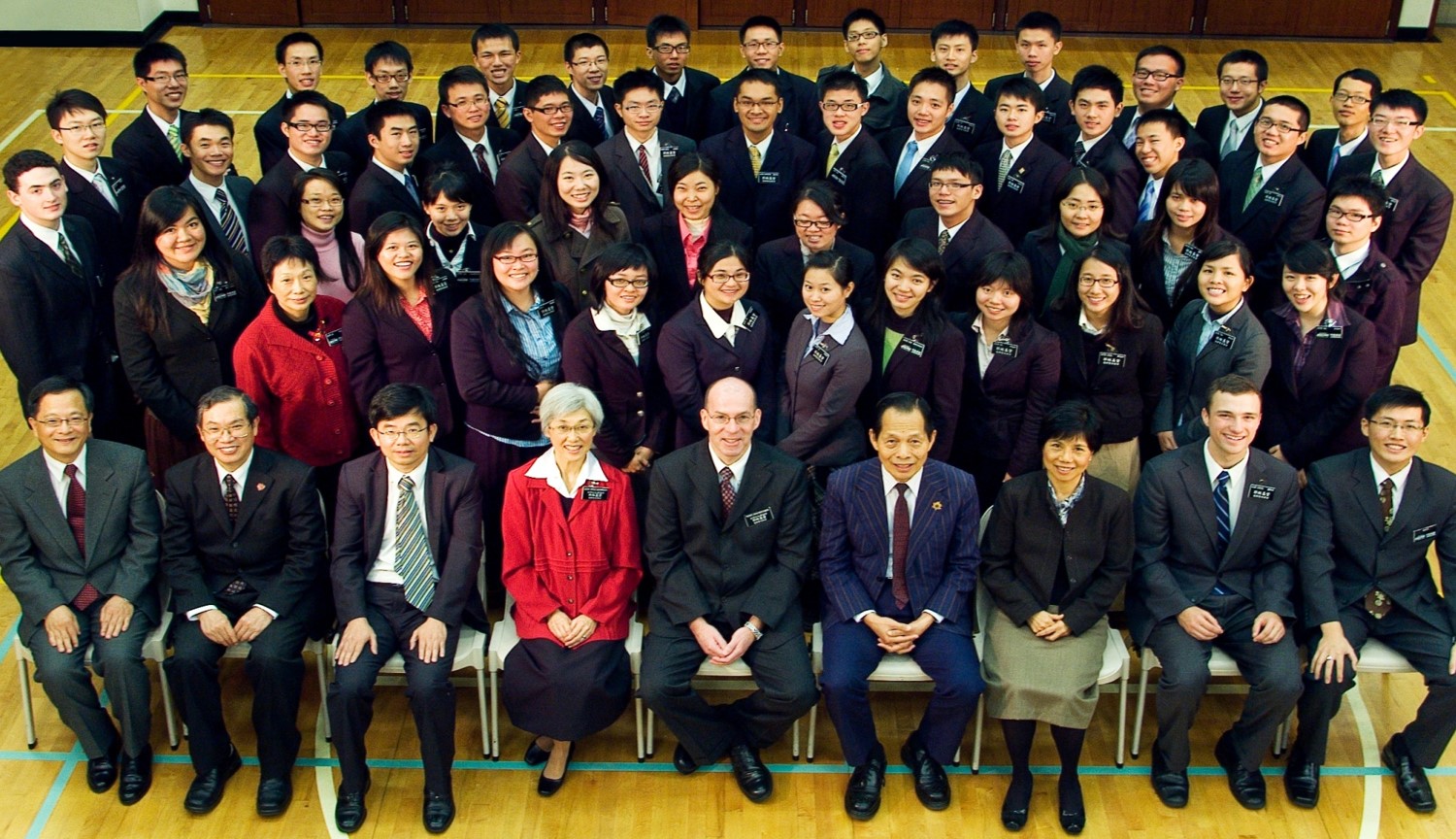 Local full-time missionaries of the Taipei mission with President Grimley (front center, Taipei Taiwan Mission president) and other leaders in 2011. Courtesy of Phil and Brenda Frandsen.
Local full-time missionaries of the Taipei mission with President Grimley (front center, Taipei Taiwan Mission president) and other leaders in 2011. Courtesy of Phil and Brenda Frandsen.
During the October 2012 general conference, President Thomas S. Monson announced that all “worthy and able young men who have graduated from high school . . . have the option of being recommended for missionary service beginning at the age of 18, instead of 19” and that young women could now serve “at age 19 instead of age 21.” President Monson prefaced his announcement by explaining, “For some time, the First Presidency and the Quorum of the Twelve have allowed young men from certain countries to serve at the age of 18 when they are worthy, able, have graduated from high school, and have expressed a sincere desire to serve . . . [which] has allowed thousands of young men to serve honorable missions and also fulfill required military obligations and educational opportunities.”[36]
Among the certain countries that were given permission to allow worthy young men to serve at the age of eighteen prior to this general policy announced in 2012 for the whole Church was Taiwan. For many years, young men in Taiwan were required to serve a two-year military service to their country, typically when they were twenty years old. Since missionary service started at nineteen, many were unable to serve or they began service only to be called back to fulfill their military service. In the early 2000s, before it was a Church-wide policy, the First Presidency and the Quorum of the Twelve Apostles had given special permission for young men in Taiwan to begin missionary service at age eighteen, allowing them to complete their two-year missionary service before being called into military service by their government, thus greatly blessing the Saints in Taiwan.[37]
Chen Ting Hui (陳定輝), the first stake president of the Chung Hsing Taiwan Stake, which was created in 2004, shared how his stake began to send young men on missions at age eighteen. He recognized early on that there were a couple of challenges facing the youth in his stake in their efforts to serve missions. First, few colleges in Taiwan allowed students to take two years off from their studies, so Chen spoke to various universities, explaining the Church’s missionary program. Next, many who served at age nineteen in Taiwan were called back halfway through their mission or at age twenty to fulfill their military obligation. Consequently, Chen worked with the military and also requested exception from leaders in Salt Lake to allow eighteen-year-olds to serve missions when the policy then for missionary service was to recommend only those who were at least nineteen years old.[38]
Over and over again, Chen requested an age exception, and over and over again he received permission for eighteen-year-olds to serve early so they could return to fulfill their military obligation. He reported that one year, he had as many as thirty missionaries serving from his stake alone.[39] Noting Chen’s success, other stakes began to call President Chen to ask about this, and not long after, the First Presidency and the Quorum of Twelve approved an exception for the young men in Taiwan to begin serving at age eighteen.[40] Chen noted that for many years there were only about thirty local missionaries from Taiwan serving each year, but in 2015 there were about one hundred or so going each year. Both the reduced military service time to four months and the age change for missionary service have directly increased the number of local missionaries serving in Taiwan.[41]
Other important events during this period included the All Taiwan Returned Missionary Reunion, as well as the public affairs efforts of the Church that helped to expand exposure of the Church. In 2010 and 2011, several returned missionaries gathered for the All Taiwan Returned Missionary Reunion prior to general conference. The 2010 reunion was held in Taipei with over one hundred returned missionaries, while the 2011 reunion was in Taichung with about three hundred people and was promoted through social media. Elder and Sister Frandsen, along with many others members, organized the “reunion for all missionaries who have ever served in Taiwan or from Taiwan who have ever served anywhere” else. There were many hugs, smiles, and pictures, and there was a lot of great food as well. Elder Weldon Kitchen was the keynote speaker in 2011. This was a great opportunity to reflect on their past missionary experiences and reconnect with each other.[42]
Public Affairs and Humanitarian Aid
Through the efforts of public affairs missionaries such as Elder and Sister Frandsen, the exposure of the Church was enhanced in the media and for the Chinese people in Taiwan. They worked with Liang Shih-An (Kent), then the public affairs director for the Church in Taiwan. Public affairs events included various concerts by guest LDS artists like the Kim Family, Hilary Demske, Janice Kapp Perry, Jenny Phillips, Michael McLean, Beyond 5, and others. It also included premieres of movies such as Emma Smith: My Story and 17 Miracles. In each of the various events, media outlets created exposure for the Church in various regions of the island and helped the Church come out of obscurity. These events also helped to build bridges with other religious groups and government officials throughout the island. The use of social media and the Internet, along with the media exposure, helped many Chinese people in Taiwan become better acquainted with The Church of Jesus Christ of Latter-day Saints.[43]
In addition, the Church has provided humanitarian aid and welfare services in Taiwan since the 1980s. Although humanitarian aid for major disasters would continue, the arrival of humanitarian and welfare couple missionaries further expanded these services for local projects. Karl and Maurine Wheatley, who followed the Sparrows, managed the humanitarian funds of the Church in Taiwan in 2010. Elder and Sister Wheatley said that they managed and allocated up to $1,000 US dollars per stake to assist in local efforts with the community. The Area Presidency approved funds based on the following criteria: projects were to help a bona fide organization in the community, projects would involve members of the stake and community, and the purpose of the project was clear and reported afterwards.[44]
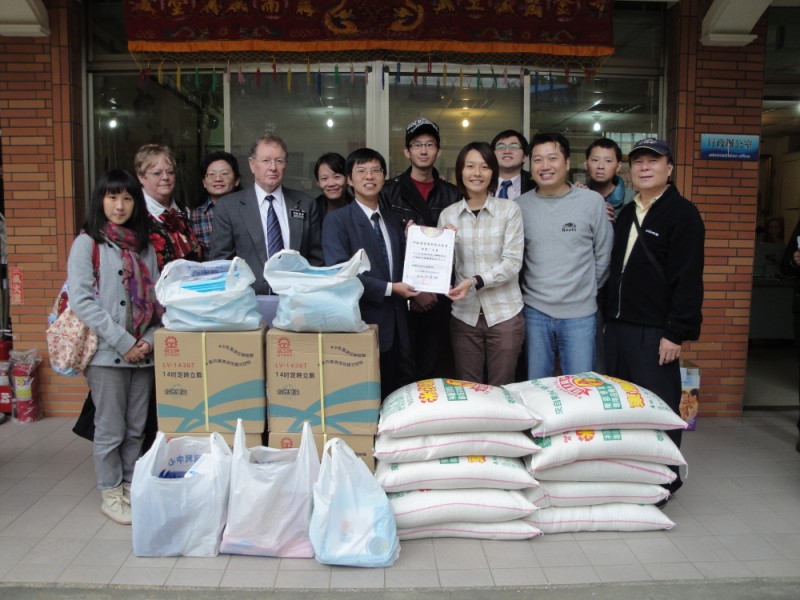 Members of the Taoyuan Stake provide food, supplies, and service at the Chenshanmei Social Welfare Foundation in Zong Li in October 2010. The Foundation assists in the care of disabled adults in the community. Courtesy of Karl and Maurine Wheatley.
Members of the Taoyuan Stake provide food, supplies, and service at the Chenshanmei Social Welfare Foundation in Zong Li in October 2010. The Foundation assists in the care of disabled adults in the community. Courtesy of Karl and Maurine Wheatley.
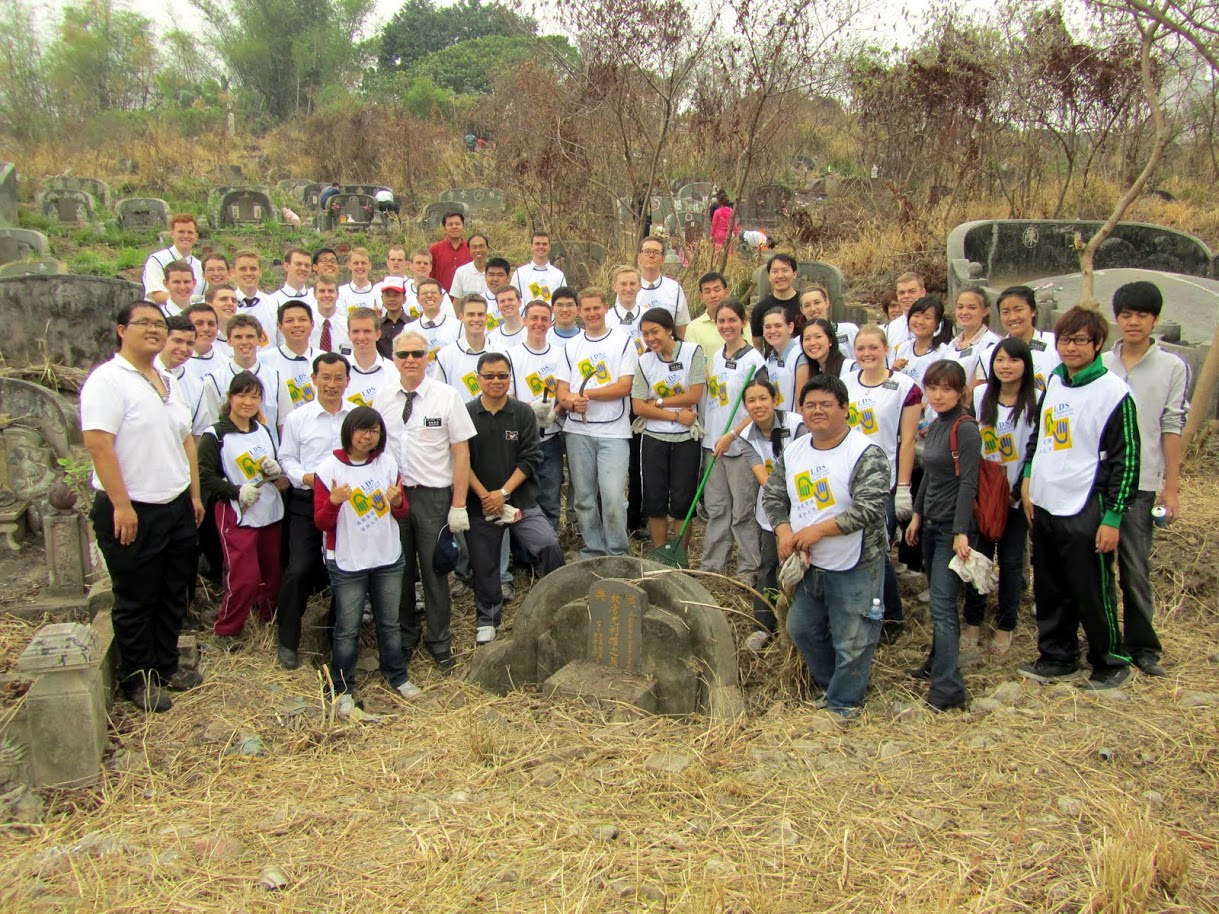 Mormon Helping Hands project in Kaohsiung to help clean a local cemetery in 2011. Courtesy of Phil and Brenda Frandsen.
Mormon Helping Hands project in Kaohsiung to help clean a local cemetery in 2011. Courtesy of Phil and Brenda Frandsen.
Various humanitarian projects helped to include youth, young adults, and other members as they worked with local community organizations. Examples of these projects included cleaning up after a storm or flooding, painting walls and furniture for various Buddhist and Catholic organizations, delivering rice and food for youth and autism community centers, providing computers and refrigerators to other community organizations, providing shoes for children at autistic centers, and so forth. Members from the Taitong Branch, for example, made vests for children and helped to clean, repair, and paint a Catholic orphanage. Youth and leaders in the Taipei West Stake spent three Saturdays helping to paint a facility for the mentally impaired. Members of the Taichung Stake worked with others in the community to sew puppets for children in challenging homes. The Hsinchu Stake prepared games and taught cooking lessons at a local shelter for mentally impaired teenagers, and also made and delivered blankets for the elderly at a nursing home. These and many other projects helped to bless orphans, the mentally impaired, the elderly, and many others throughout Taiwan. They also blessed the members of the Church who participated in these efforts, for they became the Lord’s hands in lifting the weak, poor, and needy.[45]
Employment Resource Service Center and Self-Reliance Services
When the Taipei Employment Resource Service Center (ERSC) was created in February 2000, it was designed to help members in transition, understand their potential, work on their résumés, prepare for interviews, and find job opportunities. It also provided training for employment specialists and supported the efforts of priesthood leaders to assist members in finding employment. In 2001, the Taipei ERSC visited various units to help provide support and training.[46] Some stakes in Taiwan called employment specialists who provided a series of lessons to assist these members. A letter from the Asia Area Presidency announced the establishment of three ERSCs in 2006 with their respective agent stake presidents and ERSC directors in the Taipei, Taichung, and Kaohsiung areas.[47] This letter noted that “the employment needs of members of the Church are a priesthood matter.” It noted that the role of the ERSC was to support Church leaders “in their efforts to help individuals become career self-reliant through employment, education, and self-employment.”[48]
In 2009, a new DVD and booklet were sent to stake and district presidents around the world, including Taiwan. The new DVD, titled Basic Principles of Welfare and Self-Reliance, and the booklet, Providing in the Lord’s Way: Summary of Leader’s Guide to Welfare, helped to train local leaders how to administer using Church welfare principles. According to Bishop H. David Burton, then the Presiding Bishop of the Church, “The training will help stake and ward leaders be better prepared to teach and encourage Church members to live principles of provident living and self-reliance.” Moreover, Bishop Burton shared five basic welfare principles which included the following: seek out the poor, promote personal responsibility, sustain life rather than lifestyle, provide commodities before cash, and provide work and service opportunities.[49]
In 2014, Chad Furness was hired as the first director for the Self-Reliance Service (SRS), replacing the Employment Resource Service Center (ERSC). In addition to the previous services by the ERSC, the new SRS administers the Perpetual Education Fund (PEF) and assists individuals in advancing their education and career using gospel principles. The SRS works with local priesthood leaders, the Relief Society, and self-reliance specialists in each ward and branch. They use the scriptures and principles taught by the Savior and his servants to help members of the Church gain self-reliance and become disciples of Christ. Furness used a Chinese parable to explain the purpose of the SRS: “It is better to teach a person how to fish than to give them a fish.” He also shared the four principles of self-reliance: exercise faith in the Lord Jesus Christ, be obedient, take action, and become unified with the Lord.[50]
Visits and Training by Apostles and Auxiliary Leaders
From 2000 to 2015, local leaders, members, and missionaries were blessed by a series of visits and training by members of the Quorum of the Twelve Apostles and by General Auxiliary leaders of the Church.
Elders Scott and Bednar
On 27 April 2008, Elder Richard G. Scott of the Quorum of the Twelve Apostles visited Taiwan and held a special fireside attended by about four thousand members and investigators from Central Taiwan, including those from the Hsinchu Stake, Chung Hsing Stake, North Taichung Stake, and Taichung Stake.[51] Wu Chung Kai (Ken) (吳仲凱), who served in the Taichung Stake presidency, said that Elder Scott reminded the brothers to be more sensitive to the needs of the sisters and to love them by doing simple things, such as opening the door for them or holding their chair as they prepared to sit. Brother Wu noted Elder Scott’s teachings left a lasting impression on him.[52] Sister Lee Tsai Shu-Min (Bridget) (李蔡淑敏) said that she could feel the great love that Elder Scott had for his wife, even though she had passed away.[53]
From 16 to 20 April 2009, Elder David A. Bednar of the Quorum of the Twelve Apostles visited Kaohsiung, Taichung, and Taipei. He met with the Taichung Mayor Hu (胡志強).[54] Wu Wang Hui-Ching (Emily) (吴王惠卿), who helped translate during the Taichung Stake conference, said that Elder Bednar used many relatable examples, such as the Chinese spinning plates on a long stick, noting that in order to keep all the plates from falling, one had to keep spinning them faster. In acknowledging the many single mothers who are trying to “keep all the plates in the air,” Elder Bednar shared his experience of being taught by his mother about faith, because his father was not a member of the Church.[55]
 Elder David A. Bednar visits Taiwan in 2011. From left to right: Sister and President Grimley (Taipei Mission president), Sister and Elder Jay E. Jensen of the Seventy, Elder and Sister Bednar, Sister and President Watson (Asia Area President), Sister and Elder Juan and Elder Wong of the Seventy. Courtesy of Phil and Brenda Frandsen.
Elder David A. Bednar visits Taiwan in 2011. From left to right: Sister and President Grimley (Taipei Mission president), Sister and Elder Jay E. Jensen of the Seventy, Elder and Sister Bednar, Sister and President Watson (Asia Area President), Sister and Elder Juan and Elder Wong of the Seventy. Courtesy of Phil and Brenda Frandsen.
From 27 to 29 May 2011, Elder Bednar returned and visited Taiwan with his wife, Susan. Brother Huang Yong Da (黃永達) said that Elder Bednar asked the leaders the following questions: “What are three things about your calling that keeps you from sleeping at night?” and, “What does the Lord want you to do to best serve the members?” The leaders were reminded by this Apostle that their primary role was not to administer but to minister to the members.[56]
In 2011, Elder Bednar also held a meeting for the young single adults and youth while in Taipei, which was broadcasted to various locations throughout Taiwan, including Hualien, Taitung, Taichung, Chung Hsing, and Tainan. Rather than reciting a prepared talk, he used a question-and-answer format to teach, inviting questions from the audience and by telephone from those in other locations. He received questions such as how to find an eternal companion, how to help the lost sheep return to the fold, when to serve a mission, how to strengthen new members, and so forth. He responded by encouraging the audience to develop the qualities they are looking for in an eternal companion, to study the Book of Mormon to help others return to the Church, and to discuss with parents and priesthood leaders about when to serve a mission.[57]
Several youth shared their experience trying to follow Elder Bednar’s counsel to be more proactive in their gospel learning. Sister Tsai Yi-Jing (蔡宜瑾), for example, decided to ponder the meaning of the scriptures and how to better apply them in her life. Her efforts brought peace and inspiration as she faced her challenges. Brother Shu Yang-Chong (蘇揚仲) sought to always attend class on time, to ask questions, to listen to the promptings of the Holy Ghost during class, and to seek answers and discuss the lesson with others after class. By taking upon him Elder Bednar’s counsel, Shu had more energy in school and improved his schoolwork.[58]
Brother Shu Shen-An (許慎安) remembered how tired he was when he first attended seminary. His seminary teacher shared what Elder Bednar taught about being prepared and proactive, so he began to read his scriptures regularly at night and studied the student guide for further understanding. He hoped he could maintain this practice and get up early to learn more.
Finally, Sister Shen Yin (沈妍) chose to be proactive by studying her scriptures daily and memorizing a scripture mastery weekly, which helped her to listen more attentively during seminary. She gained a testimony as she listened, knowing that what her teacher taught was true. She said that there were a lot of temptations at school and everyone was trying to get her into viewing pornography. But seminary helped her to refuse her classmates invitations, even to the point where she left class to go to a quiet place to pray. She was grateful to make right choices and was able to feel the Spirit while at school.[59]
The question-and-answer format used by Elder Bednar, along with his use of scriptures to respond to questions, left a deep impression upon the Church leaders and members in Taiwan. For example, Brother Wang Jung Ling (王榕翎) learned from Elder Bednar’s example that one can turn to the Holy Ghost and the scriptures to find answers.[60] Sister Weng Chen Shu-Mei (翁陳淑梅) also admired the usage of the scriptures by Elder Bednar to answer questions and learned the key role of the scriptures in sharing the gospel in the latter-days.[61] Brother Hong Wei-Chin (洪偉欽) remembered Elder Bednar’s focus on the young single adults in Taiwan and on strengthening faith.[62] Brother Wu Chung-Kai (Ken) (吳仲凱) noted that Elder Bednar used the scriptures to respond to the questions and observed his remarks that his favorite sound is the turning pages of the scriptures. Wu also said that Elder Bednar encouraged the members to diligently study the scriptures to understand the doctrine.[63]
President Uchtdorf and Elder Christofferson
In May 2010, Elder D. Todd Christofferson of the Quorum of the Twelve Apostles presided over the Hsinchu Stake conference. He was accompanied by Elder Chung Kuo Chiang (Joseph) (仲國強), an Area Seventy. The Hsinchu stake president, Hong Wei-Chin (洪偉欽), and the members of his stake were grateful to have an apostle of the Lord visit their stake.[64]
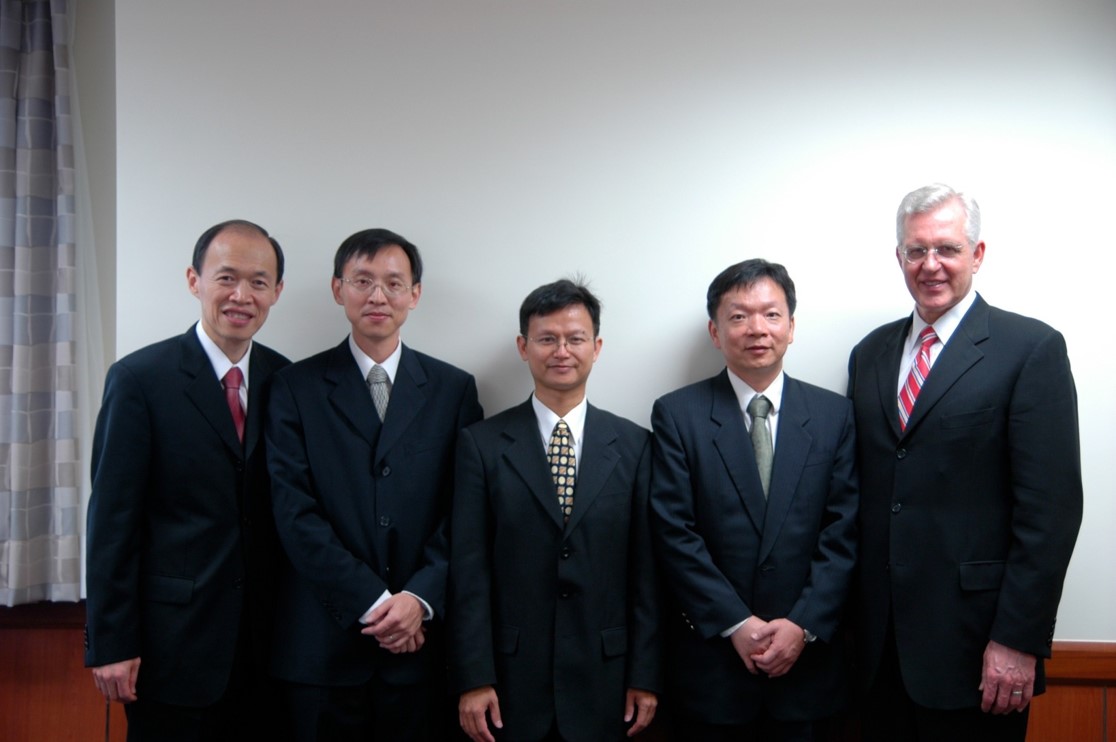 May 2010. Elder D. Todd Christofferson (right) visits the Hsinchu stake presidency and presides over their stake conference with Elder Chung Kuo Chiang (left). Hong Wei-Chin (center) is the first president of the Hsinchu Stake. Courtesy of Phil and Brenda Frandsen.
May 2010. Elder D. Todd Christofferson (right) visits the Hsinchu stake presidency and presides over their stake conference with Elder Chung Kuo Chiang (left). Hong Wei-Chin (center) is the first president of the Hsinchu Stake. Courtesy of Phil and Brenda Frandsen.
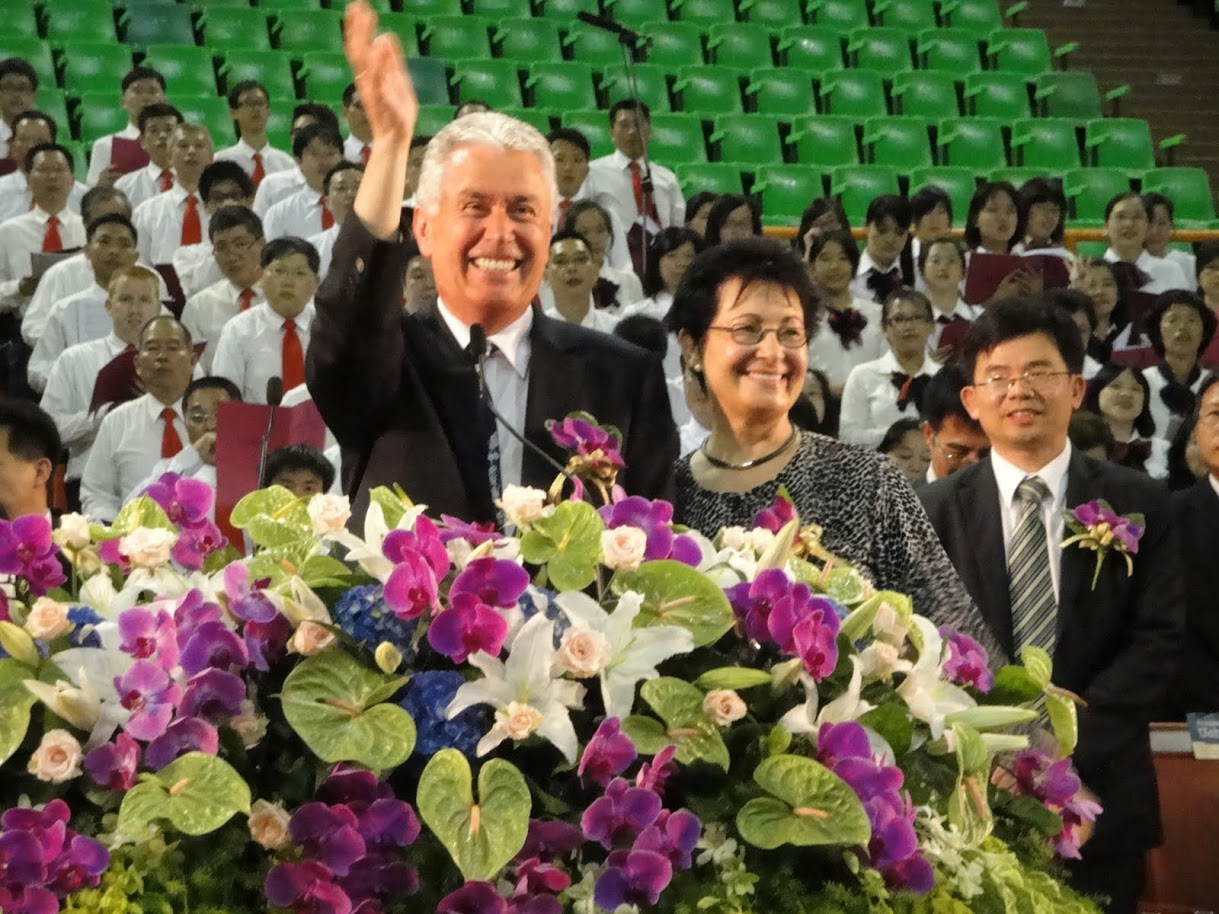 Dieter F. and Harriet Utchdorf hold a special meeting at Lin Kou National Athletic University in Taoyuan on 11 July 2010. Courtesy of Phil and Brenda Frandsen.
Dieter F. and Harriet Utchdorf hold a special meeting at Lin Kou National Athletic University in Taoyuan on 11 July 2010. Courtesy of Phil and Brenda Frandsen.
On 11 July 2010, President Dieter F. Uchtdorf, second counselor in the First Presidency, and his wife, Harriet, visited Taiwan accompanied by President Anthony D. Perkins and Elder Juan Jui-Chang (阮瑞昌).[65] They visited Lin Kou National Athletic University in Taoyuan for a special meeting with the members of the Church in Taiwan and to pick up their twin grandsons who were serving in each of the two missions in Taiwan. Elder Juan, who conducted the meeting, recalled President Uchtdorf saying that the handbook did not encourage parents to pick up their children after their mission, but commented, “I am a grandpa,” eliciting laughter from the audience of about six thousand people.[66]
Sister Liao Hsieh Man-Fen (廖謝曼芬) reported that it was her first time seeing a member of the First Presidency in person and that she was touched by his visit to pick up his grandsons.[67] Brother Huang Yong Da (黃永達) said that there was great excitement to see a member of the First Presidency and hear his message.[68] President Hong Wei-Chin (洪偉欽), then the stake president for the Hsinchu Stake, observed that all the members on the island were excited to see President Uchtdorf. President Hong noted that the Hsinchu Stake alone had six buses filled with over two hundred members that traveled to Taoyuan to join between six thousand and seven thousand members who attended this meeting.[69]
President Uchtdorf encouraged the Saints to do three things regularly: daily prayer, daily scripture study, and weekly family home evening.[70] Afterward, he invited his missionary grandsons, serving respectively in the Taipei Taiwan and Taichung Taiwan Missions to share their testimonies, and then he shook hands with the members.[71]
Elders Holland and Stevenson
On 18–19 February 2006, Elder Jeffrey R. Holland of the Quorum of the Twelve visited the West Taipei Taiwan Stake.[72] Chang Jui-Sheng (張瑞昇) from Taichung recalled the love he felt from Elder Holland, who chose to shake hands with each person who attended this meeting, even though he recently injured his shoulder.[73]
On 22–23 February 2014, Elder Holland returned to Taiwan with other leaders and held various meetings with priesthood leaders, missionaries, and members in Taiwan. Elder Holland presided over the Taiwan Taipei West Stake conference and priesthood leadership conference for leaders in Taiwan. During the four-hour priesthood leadership conference, Elder Holland answered questions and noted that he had “never been in a meeting where there were better questions asked than in Taiwan. . . . That suggests the maturity of the Church there.”[74]
Liao Ji-Shuen (廖吉順), the stake president of the West Taichung Taiwan Stake, recalled that although exhausted and jet-lagged from visiting so many countries, Elder Holland was an example of one who served with all his energy.[75] Brother Huang Yong Da (黃永達) also recalled that although he was very tired, Elder Holland still came to Taipei to teach and train. Brother Huang added that if the members of the Quorum of the Twelve work so diligently, as members of the Church we can also work hard.[76] Elder Holland also took time to shake hands and said that “when I shook their hands, when I looked them in the eye, I saw a wonderful generation of young people giving faithful, devoted missionary service. . . . It was for me a new, fresh, bright look to the Church in Taiwan.” He noted that many of the local leaders were returned missionaries and were also second-, third-, or fourth-generation members of the Church in Taiwan.[77]
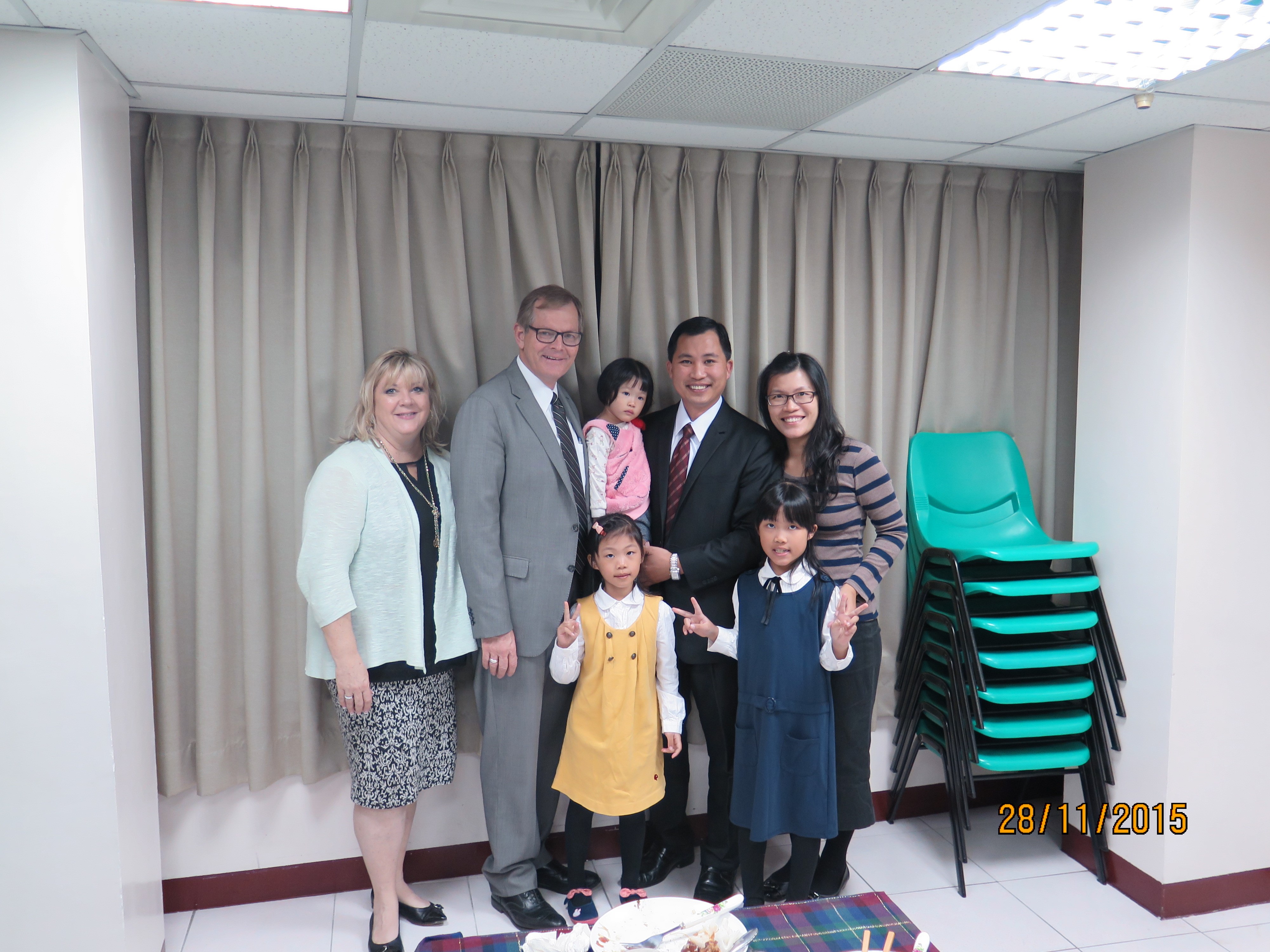 Gary Stevenson (second from left) and Lesa Jean Stevenson visit the Tainan Taiwan Stake in 2015, pictured with Liu Te-Lung (Tainan Stake president) and his family. Courtesy of Liu Te-Lung.
Gary Stevenson (second from left) and Lesa Jean Stevenson visit the Tainan Taiwan Stake in 2015, pictured with Liu Te-Lung (Tainan Stake president) and his family. Courtesy of Liu Te-Lung.
On 28 November 2015, Elder Gary E. Stevenson of the Quorum of the Twelve and his wife visited with a few members of the Tainan Taiwan Stake, where their oldest son was completing his full-time missionary service. Liu Te-Lung (劉德龍), the stake president of the Tainan Taiwan Stake at the time, recalled Elder Stevenson speaking about a training he received that helped him to focus on being a better husband and father. Liu explained that the Apostle taught them that the brothers tend to listen with their mind while the sisters listen with their heart, and then Elder Holland “encouraged the brothers to learn to listen like the sisters.” The brief visit left a powerful impression upon those in attendance.[78]
Other Leaders
Other leaders who visited Taiwan during this period included Elaine S. Dalton and Rosemary M. Wixom, respectively the Young Women and Primary general presidents of the Church in 2010.[79] In November 2012, Sister Mary N. Cook and Linda S. Reeves, counselors in the Young Women and Relief Society General Presidencies, respectively, also visited Taiwan as the new Come, Follow Me youth curriculum was announced.[80] Sister Huang Hui-Hsine (黃慧嫺) was touched by the visit of members of the general auxiliary presidencies to Kaohsiung when so many others in the world needed their visit. Sister Huang said that she felt the leaders’ love for the sisters in Taiwan during their discussion and dinner, and was grateful for the opportunity to converse with these general auxiliary officers of the Church, sharing the experiences and challenges of the local sisters in Taiwan.[81]
Chou Po Nien (Felipe) (周伯彥) was among those called and set apart to serve in the Curriculum Resource Committee of the Church in Salt Lake City, Utah. This committee worked on a variety of curriculum resource materials including the Duty to God and Personal Progress resources and the Come, Follow Me curriculum. He noted that this committee of volunteers worked alongside full-time employees at the Church Office Building in Salt Lake City, tasked with developing a new youth curriculum that would help the youth of a world-wide Church to learn how to teach one another and thus deepen their conversion.[82] Sister Tsai Huang Li-Yu (蔡黃麗瑜), who has served in various callings with the youth of the Church, believed that the changes in the new youth curriculum have also contributed to preparing the youth for their missions and service in the Church. The new Come, Follow Me youth curriculum provides additional media resources and invites more participation from the youth.[83]
Conclusion
During this period, new Area Seventies from Taiwan were called, and there were also changes in missions and training for local missionaries called to serve in Taiwan. The Saints in Taiwan also received visits by additional members of the Quorum of the Twelve and other general auxiliary leaders, providing additional training for local Church leaders and members throughout the island. The elders of Israel continue to minister and strengthen the Saints in Taiwan.
Notes
[1] Stamps and Shamo, The Taiwan Saints, 15–16; Joseph G. C. Jung (or Chung), “The Book Changed My Life,” Liahona, February 1988, 9–10.
[2] “New General Authorities, Young Men Presidency and Primary Presidency Changes Announced,” Mormon Newsroom, 4 April 2015, http://
[3] Juan Jui-Chang, interview by Chou Po Nien (Felipe), 15 November 2015, Taichung, Taiwan.
[4] Juan Tsai Chia-Hsiu, interview by Chou Po Nien (Felipe), 15 November 2015, Taichung, Taiwan.
[5] Juan Jui-Chang, interview by Chou.
[6] Juan Tsai Chia-Hsiu, interview by Chou.
[7] Juan Jui-Chang, interview by Chou.
[8] Stamps and Shamo, The Taiwan Saints, 27–28.
[9] Sarah Jane Weaver, “New Area Seventies Called to Sixth and Eighth Quorums,” Church News, 7 May 2015.
[10] Kuan Ming-Shun, interview by Chou Po Nien (Felipe), 15 November 2015, Taichung, Taiwan.
[11] Fang Lu-Ping, “New Asia Area Seventy Report, Elder Kuan Ming-Shun,” Taiwan Local Church News, 19 April 2015, http://
[12] Kuan Chen Wen-Lin, interview by Chou Po Nien (Felipe), 15 November 2015, Taichung, Taiwan.
[13] Kuan Chen Wen-Lin, interview by Chou.
[14] Fang Lu-Ping, “New Asia Area Seventy Report, Elder Kuan Ming-Shun”; Kuan Ming-Shun, interview.
[15] William Shiu-Foo Hsu (徐筱夫) served as the mission president for the Taiwan Kaohsiung Mission until 2009, when it was closed and consolidated with the Taiwan Taichung Mission. In Taichung, after Scott R. Watterson (黃仲傑) was released as the mission president of the Taiwan Taichung Mission in 2007, Michael A. Hoer (霍廷昌) was called and served from 2007 to 2010; after him, Clark T. Bishop (仲世民) served from 2010 to 2013; after Bishop, Kurt L. Blickenstaff (康文甯) began serving in 2013 and continued until 2016; and, finally, Michael John U. Teh (戴西安) was called to serve in 2016. Meanwhile, the mission presidents of the Taiwan Taipei Mission included Norman S. Nielson (王孝賢) from 2006 to 2009; Terence E. Grimley (葛忠信) from 2009 to 2012; David O. Day (范孟彥) from 2012 to 2015; and Jace B. Jergensen (江耀雲), who arrived in 2015. Each of these mission presidents worked with missionaries, leaders, and members to help build the Church in Taiwan.
[16] Brenda Frandsen to Chou Po Nien (Felipe), email, 13 February 2016.
[17] Brenda Frandsen to Chou Po Nien (Felipe), email; Brenda Frandsen, “The History of the Church of Jesus Christ of Latter-day Saints in MaGong,” personal record, copy in possession of authors.
[18] Brenda Frandsen to Chou Po Nien (Felipe), email; Brenda Frandsen, “Golden Prospects in Kinmen,” personal record, copy in possession of authors.
[19] 1 Nephi 19:16.
[20] Brenda Frandsen to Chou Po Nien (Felipe), email; Brenda Frandsen, “New Referral System Enhances Missionary Work in Taiwan.”
[21] Brenda Frandsen to Chou Po Nien (Felipe), email; Brenda Frandsen, “New Referral System Enhances Missionary Work in Taiwan.”
[22] Brenda Frandsen to Chou Po Nien (Felipe), email; Brenda Frandsen, “New Referral System Enhances Missionary Work in Taiwan.”
[23] Brenda Frandsen to Chou Po Nien (Felipe), email; Brenda Frandsen, “New Referral System Enhances Missionary Work in Taiwan.”
[24] “New Taiwan Website Marks 80th for Mormon Newsroom,” Mormon Newsroom, 9 August 2016, http://
[25] Dennis C. H. Kim, “Taiwan Taichung Mission History: 1998–2001,” personal record, copy in possession of authors.
[26] Kim, “Taiwan Taichung Mission History: 1998–2001.”
[27] Chiu Hsin-Yao, interview by Chou Po Nien (Felipe), 22 October 2015, Provo, UT.
[28] Chiu Hsin-Yao, interview by Chou.
[29] Chiu Hsin-Yao, interview by Chou.
[30] Chiu Hsin-Yao, interview by Chou.
[31] “Around the Church: Apostle Dedicates New MTC in Philippines,” Liahona, October 2012, 78.
[32] Lee Shih-Jung (Robert), interview by Chou Po Nien (Felipe), 29 August 2015, Provo, UT.
[33] Huang Yong Da, interview by Chou Po Nien (Felipe), 13 November 2015, Taichung, Taiwan.
[34] Lee Shih-Jung (Robert), interview by Chou.
[35] Mao Chang Mei-Yun, interview by Chou Po Nien (Felipe), 14 November 2015, Taichung, Taiwan.
[36] Thomas S. Monson, “Welcome to Conference,” Ensign, November 2012, 4–5.
[37] Chou Po Nien (Felipe), personal history and journal entries, 2004–2005.
[38] Chen Ting Hui, interview by Chou Po Nien (Felipe), 14 November 2015, Taichung, Taiwan.
[39] Chen Ting Hui, interview by Chou.
[40] Chou, personal history and journal entries, 2004–2005.
[41] Chen Ting Hui, interview by Chou.
[42] Phil Frandsen and Brenda Frandsen, interview by Chou Po Nien (Felipe), 19 February 2016, Cedar Hills, UT; Brenda Frandsen to Chou Po Nien (Felipe), email, “All Taiwan Returned Missionary Reunion,” 15 February 2016; Brenda Frandsen to Chou Po Nien (Felipe), email, “2011 All Taiwan Returned Missionary Reunion,” 15 February 2016.
[43] Phil Frandsen and Brenda Frandsen, interview by Chou; Brenda Frandsen to Chou Po Nien (Felipe), email.
[44] Karl and Maurine Wheatley, interview by Chou Po Nien (Felipe), 23 March 2016, Salt Lake City.
[45] Wheatley and Wheatley, interview by Chou.
[46] Brittany Karford, “News of the Church,” Ensign, July 2006, 77; “Taipei Employment Resource Center,” Liahona (Chinese), February 2001, n-15.
[47] Daryl H. Garn, Donald L. Hallstrom, and D. Allen Andersen, “Volunteer LDS Employment Resource Service Centers,” letter from the Asia Area Presidency dated 22 March 2006, copy in possession of authors.
[48] Garn, Hallstrom, and Andersen, “Volunteer LDS Employment Resource Service Centers.”
[49] Lisa Barton, “News of the Church: Stakes Receive Training on Welfare and Self-Reliance,” Ensign, July 2009, 74–75.
[50] Fan Lu Ping, “Taiwan Self-Reliance Service Center,” Liahona (Chinese), March 2015, n-2–4.
[51] Wang Hui Chuen, “Apostle Elder Richard G. Scott Comes for a Special Fireside,” Liahona (Chinese), August 2008, n-11–13.
[52] Wu Chung Kai (Ken), interview by Chou Po Nien (Felipe), 21 November 2015, Taipei, Taiwan.
[53] Lee Tsai Shu-Min (Bridget), interview by Chou Po Nien (Felipe), 16 November 2015, Kaohsiung, Taiwan.
[54] Yang Pon Mei Chien, Yang Wang Hui Chuen, Lin Hong Hui Chuen, “Apostle Elder David A. Bednar and Wife Visit Taiwan,” Liahona (Chinese), July 2009, n-10–12.
[55] Wu Wang Hui-Ching (Emily), interview by Chou Po Nien (Felipe), 21 November 2015, Taipei, Taiwan.
[56] Huang Yong Da, interview by Chou.
[57] “Act Upon the Word: Elder David A. Bednar and Elder Jay Jensen Visit Taiwan,” Liahona (Chinese), September 2011, n-2–5.
[58] Wang Jung Ling, “Being Proactive: Young Men and Young Women Follow the Apostle’s Teaching,” January 2011, Liahona (Chinese), n-3–5.
[59] Wang, “Being Proactive: Young Men and Young Women Follow the Apostle’s Teaching,” n-3–5.
[60] Wang Jung Ling, interview by Chou Po Nien (Felipe), 22 November 2015, Taipei, Taiwan.
[61] Weng Chen Shu-Mei, interview by Chou Po Nien (Felipe), 14 November 2015, Taichung, Taiwan.
[62] Hong Wei-Chin, interview by Chou Po Nien (Felipe), 21 November 2015, Taipei, Taiwan.
[63] Wu Chung Kai (Ken), by interview Chou.
[64] Hong Wei-Chin, interview by Chou.
[65] Chien Chie-Fang, “Come, Listen to a Prophet’s Voice: Second Counselor of the First Presidency, President Dieter F. Uchdorf and His Wife,” Liahona (Chinese), December 2010, n-6–7.
[66] Juan Jui-Chang, interview by Chou.
[67] Liao Hsieh Man-Fen, interview by Chou Po Nien (Felipe), 14 November 2015, Taichung, Taiwan.
[68] Huang Yong Da, interview by Chou.
[69] Honng Wei-Chin, interview by Chou.
[70] Chien, “Come, Listen to a Prophet’s Voice,” n-6–7.
[71] Lee Tsai Shu-Min (Bridget), interview by Chou.
[72] Chung Chen Mei-Hua, “Apostle’s Visit,” Liahona (Chinese), June 2006, n-10.
[73] Chang Jui-Sheng, interview by Chou Po Nien (Felipe), 14 November 2015, Taichung, Taiwan.
[74] Sarah Jane Weaver, “Elder Holland Visits Asia, ‘Great Work Unfolding Here,’” Church News, 23 March 2014, 4–5.
[75] Liao Ji-Shun, interview by Chou Po Nien (Felipe), 14 November 2015, Taichung, Taiwan.
[76] Huang Yong Da, interview by Chou.
[77] Sarah Jane Weaver, “The Church Is Wonderfully Well in Asia, Elder Holland Reports,” Church News, 25 March 2014, https://
[78] Liu Te-Lung to Chou Po Nien (Felipe), email, 17 December 2015.
[79] Lin Hung Hui-Chuan, Wang Hui-Chuan, and Lee Tien-Shuen, “General Auxiliary Leaders Visit Taiwan, Elaine Dalton and Rosemary Wixom,” Liahona (Chinese), December 2010, n-7–8.
[80] “Young Women and Relief Society General Leaders Tour Asia Area,” Liahona, April 2013, 78.
[81] Huang Hui-Hsine, interview by Chou Po Nien (Felipe), 13 November 2015, Taichung, Taiwan.
[82] Chou Po Nien (Felipe), personal history and journal entries, 2012.
[83] Tsai Feng-Cheng, interview by Chou Po Nien (Felipe), 21 November 2015, Taipei, Taiwan.
